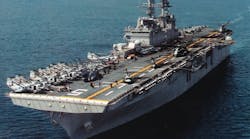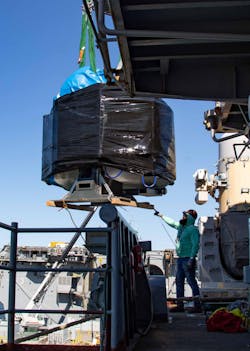RELATED: Air Force Uses 3D-Printed Parts on Transport Planes
One of the long-touted possibilities of 3D printing (also known as rapid prototyping and additive manufacturing) has been for the military to make replacement parts and repairs tools for machines and equipment when deployed in the field. That would cut down on the amount of replacement parts troops need when far from the U.S. and possibly near or at the front in any military actions. It would also eliminate the supply chain and logistics needed to keep equipment up and running.
The Navy is testing that theory by putting a the first 3D printer onboard a ship, the USS Bataan (LHD 5). It’s a Wasp-class amphibious assault ship that was commissioned in 1997.
The overall machine is termed a hybrid because engineers from Phillips Corp. worked to combine wire-laser metal 3D printer hardware from Meltio with a 3D milling machine and CNC control from Haas’ TM-1 platform.
The Haas TM-1 CNC milling machine and controls have already been tested on several aircraft carriers. Combining the Meltio deposition head, which will print parts out of 316L stainless steel—a prevalent material in U.S. Navy ships—with the TM-1 gives the Bataan crew additive and subtractive manufacturing in one package. It should increase machine efficiency and reduce waste compared to traditional machining.
The deposition head is held in an enclosure solidly connected to the spindle mount. During milling the deposition head is protected, but it can be automatically deployed when required by the program. It is not possible to do both milling and 3D printing at once, but alternating them is, and there’s no need for technicians to intervene.
READ MORE: NASA Uses 3D Printing to Bring the Cost of Space Exploration Down to Earth
“The build envelope for the 3D printer encompasses the same volume defined by the reach of the TM-1,” says a Meltio spokesperson. “So, for the particular generation of TM-1 onboard the USS Bataan, the X, Y and Z axis travels are 30, 12, and 16 in., respectively.”
In terms of speed, the 3D printer portion can create parts (not clad them) at about 400 grams/hr). “That translates into roughly one pound per hour in steel or stainless or about three cubic inches,” says the spokesperson.
“Phillips invested considerable time in developing the combined hybrid machine, according to Meltio. They had to ensure the CNC enclosure was laser-safe and both controllers could communicate. All programs run on the Haas controller, but the parameter set is selected before operation from the Meltio controller. The deposition head also had to be accurately and securely fixed to the CNC.
Another challenge was ensuring the machine will remain accurate despite the ship moving. To eliminate this problem, the relative position of the deposition head/spindle to the build plate is rigidly controlled, preventing the influence of external factors on the process. “This is one aspect that will require further testing,” says Meltio. “Our belief is that the rigidity of the Haas machine will maintain accuracy for both deposition and machining during rough seas. Of course, the level of rough seas needs to be defined.”
READ MORE: DoD Eyes 3D Printing to Repair or Replace Older Parts
Neither the new machine or any onboard the ship can recycle any scrap metal. The scrap could, in theory, be turned into new wire, if the necessary equipment was available. For now, the small amount of waste limits the convenience and viability of recycling onboard.
“Most parts coming off the hybrid will need some post-processing and to be removed from the build plate,” says Meltio. “Heat treating parts created at sea is not something we are currently looking at due to the materials we will be using and part requirements.
“But post-processing can be part of hybrid processing. In fact, a part processed solely in the hybrid system could be fully functional right out of the machine.”
To get the crew members who will be working with the machine up to speed on its operations and maintenance, Phillips provided an initial additive and subtractive program. Phillips will also be supporting the system remotely and in the field as needed.
READ MORE: Army Explores Discarded Plastic Containers as Feedstock for 3D printers
When the system is up and operating, it will make parts based on technical data packages (TDP), which are being developed at NAVSEA. Each defines the required design configuration and procedures to manufacture a part and ensure it performs properly. The Navy plans on creating over 300 TDPs and, so far, no TDPs have been shared with the Phillips team.
NAVSEA engineers also installed a second 3D printer onboard the Bataan. It makes parts out of a plastic polymer.
“These printers will help the Navy overcome obsolescence issues for ships and systems that have service lives measured in decades and directly contribute to enhanced operational availability of our systems and ships,” says NAVSEA Chief Engineer Rear Adm. Jason Lloyd. (NAVSEA is responsible for building, buying and maintaining ships, submarines and systems for the Navy).


